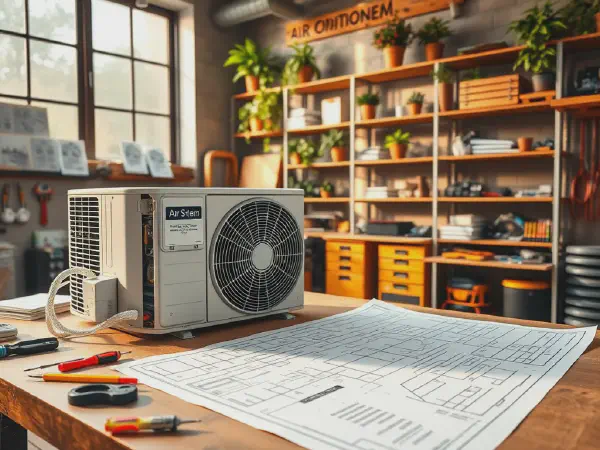Expert Guide to Split System Installation: Tips & Tricks

A Comprehensive Guide to Split System Installation
Split system installation is a crucial step in ensuring comfortable temperatures and air quality in your home or office. Unlike traditional heating and cooling systems, split systems consist of two main components: an indoor unit and an outdoor unit. The installation process requires careful planning, execution, and adherence to safety standards to ensure effectiveness and durability.
The right split system installation can significantly enhance the efficiency of the system and lower energy costs. This guide will explore various types of split systems, the installation process, cost factors, common mistakes to avoid, and the benefits of choosing split systems for your climate control needs.
Whether you are looking to replace an existing system or install a new split system in your property, understanding the installation process can help you make informed decisions. Professional installation is often recommended to ensure proper setup, optimize function, and prolong the life of your system.
From assessing your space and choosing the right model to the final testing and maintenance checks, split system installation involves several important steps. This article aims to provide a thorough overview that can assist homeowners and contractors alike in understanding each aspect of the process.
For optimal comfort in varying climates, consider investing in a split system air conditioning melbourne solution tailored to your needs.
With variations in system types, equipment, and installation procedures, being prepared will ensure that you achieve the best possible outcome for your split system installation.
Types of Split Systems
When considering split system installation, it's essential to understand the different types of split systems available. The two primary categories are ducted and ductless systems. Ducted systems are designed to distribute air through ducts, making them suitable for larger homes, while ductless systems provide flexibility and simplicity in installation, ideal for smaller spaces or areas without existing ductwork.
Additionally, split systems can be classified into single-zone and multi-zone systems. Single-zone systems serve one area, while multi-zone systems can control temperatures across multiple areas or rooms simultaneously, offering personalized comfort.
Energy-efficient models are also gaining popularity, designed to minimize energy consumption while maximizing cooling and heating performance. These models often come equipped with advanced technology to reduce operational costs over their lifespan.
Enhancing energy efficiency during summer months can be achieved with expert evaporative cooling installation melbourne that suits your home's design.
Another innovation in the world of split systems is inverter technology. Unlike traditional fixed-speed systems, inverter technology allows the compressor to run at variable speeds, providing precise temperature control and improved efficiency.
Lastly, portable split systems offer versatility and convenience, allowing homeowners to move units from room to room as needed without permanent installation. These systems are perfect for renters or those who want temporary climate control solutions.
Installation Process
The installation process for a split system begins with a thorough site assessment. Professionals examine the space to determine the best placement for both the indoor and outdoor units. This step includes checking for potential obstructions, accessibility for installation, and proximity to power sources.
Choosing the right location for both units is crucial, as it can influence the system's performance. The indoor unit should be installed high on the wall to facilitate air circulation, while the outdoor unit must have plenty of space for airflow and maintenance access.
The next step involves mounting the indoor unit securely to the wall. This process includes drilling holes for refrigerant and drainage lines and ensuring the unit is level for optimal function.
After mounting the indoor unit, the outdoor unit needs to be connected. This includes running refrigerant lines, electrical wiring, and drainage lines between the two units, which is essential for the system's operation.
Finally, once all the connections are made, professionals conduct thorough testing and maintenance checks to ensure the system operates efficiently. This step also includes informing homeowners about basic maintenance practices to prolong the life of their split system.
Cost Factors
Understanding cost factors is essential when planning a split system installation. Equipment prices can vary significantly based on the type and efficiency rating of the system chosen. Higher efficiency systems typically have a higher upfront cost but can lead to greater savings over time through reduced energy consumption.
Labor costs also play a significant role in overall installation expenses. Professional installation is recommended for optimal performance and safety, which can add to the initial investment. It's advised to obtain quotes from different contractors to find competitive rates.
Permitting fees may be required depending on local regulations and zoning laws. Homeowners should consult with professionals or local authorities to ensure all necessary permits are secured before installation begins.
Although initial expenses may seem daunting, considering long-term energy savings is crucial. Investing in an efficient split system can lead to reduced monthly energy bills, making it a financially sound decision.
Homeowners should also be on the lookout for seasonal discounts and promotions offered by HVAC contractors, which can help offset installation costs and provide better value for money.
Common Mistakes
Several common mistakes can occur during split system installation that can impact performance. One of the most significant errors is improper sizing of units, where a unit that is too small struggles to cool or heat adequately, while an oversized unit can cycle frequently and lead to excessive energy use.
Another mistake to avoid is neglecting insulation needs. Poor insulation can cause heat loss in winter and heat gain in summer, greatly affecting a split system's efficiency and leading to higher energy costs.
Faulty electrical hookups can also pose risks and should be avoided. If not correctly wired, the system may not function properly or could even create hazardous conditions. It's imperative to have licensed electricians handle all electrical connections.
In addition, homeowners should be aware of local codes and regulations. Ignoring these can result in fines and complications when selling the property in the future. Therefore, compliance with all building codes is essential during installation.
Lastly, skipping maintenance visits post-installation can lead to performance issues down the road. Regular maintenance ensures that the system remains efficient and prolongs its lifespan, making it a crucial part of home ownership.
Benefits of Split Systems
Split systems offer several benefits that make them a popular choice for climate control. One of the most notable advantages is energy efficiency. Many split systems have high SEER (Seasonal Energy Efficiency Ratio) ratings, ensuring that they provide significant cooling and heating while consuming less energy.
The flexibility in temperature control provided by split systems is another major benefit. Homeowners can set different temperatures for different rooms, catering to individual preferences and optimizing comfort.
Quiet operation features are also a highlight of split systems. The outdoor unit houses the compressor, resulting in quieter indoor operation that doesn’t disturb daily activities or sleep.
Additionally, split systems enhance air quality by often being equipped with advanced filtration systems that reduce allergens and dust particles in the air, contributing to a healthier indoor environment.
Lastly, split systems offer customization options with various styles, sizes, and features, allowing homeowners to choose a solution that best fits their specific needs and aesthetics.
